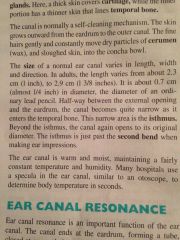![]()
![]()
![]()
Use LEFT and RIGHT arrow keys to navigate between flashcards;
Use UP and DOWN arrow keys to flip the card;
H to show hint;
A reads text to speech;
25 Cards in this Set
- Front
- Back
- 3rd side (hint)
|
Helix |
Outer edge or fold of the Auricle. |
|
|
|
Antihelix |
The inner raised are or rim |
|
|
|
Crus |
The crus of the helix overlaps the antihelix at the upper front edge. |
|
|
|
Triangular fossa |
Near the top of the auricle, between the helix and antihelix. |
Varies in length, width and direction. In adults, the length varies from 2.3 cm (1 inch), to 2.9 cm |
|
|
Scaphoid Fossa |
The bulk of the rear outer curved area. |
|
|
|
Tragus |
Outward projection or bump on the front of the ear that is suspended over the ear canal. |
|
|
|
Antitragus |
The bump or projection on the back part of the inner rim. |
|
|
|
Intertragal notch |
Back (Definition) Between the tragus and anti tragus, forms the bottom inner rim. |
|
|
|
Concha |
The small hollow or bowl leading directly into the ear canal. |
|
|
|
Aperture |
Entrance to the canal |
|
|
|
External auditory meatus |
The canal itself, it extends from the concha inward to the eardrum, |
|
|
|
Ear canal |
Is not usually straight. It curves like a figure S laying in its side, in adults it rises slightly upward then slightly forward and downward toward the eardrum. |
|
|
|
Size of ear |
Hint |

Varies in length, width and direction. In adults, the length varies from 2.3 cm (1 inch), to 2.9 cm |
|
|
Isthmus |
The narrow area halfway between the external opening and the eardrum. As it enters the temporal bone. The isthmus is just past the second bend. |
|
|
|
Canals resonate |
Most ear canals resonate between 2000 to 3000 HZ, the average frequency is about 2700 HZ. This is a combination of the pinna which resonates 2000-5000 Hz |
|
|
|
Vagus nerve (X Cranial) |
Lies along the bottom of the ear canal |
|
|
|
Eardrum |
Is called the tempanic membrane, tempanum or drum head. The malldividing line between the outer and middle ear, it is oval in shape, normal color is translucent, pearly white to pinkish grey. You can usually see through it. |

|
|
|
Arnold's reflex |
An automatic cough caused by touching the vagus nerve, usually a Q tip, an ear impression or using a hearing instrument |
|
|
|
Mucous membrane |
Inner layer which lines the middle ear cavity. |
|
|
|
Annulus or Annular ring |
Holds the eardrum in place, forming a watertight and air tight seal between the external and middle ear. |
|
|
|
Malleus |
The eardrum is attached to the malleus in the middle ear. The malleus is suspended from the top of the eardrum to a point about 2/3 of the way down the drum. |
|
|
|
The Umbo |
At the point where the tip of the malleus ends forming the innermost tip of the cone. |
|
|
|
Cone of light |
Light from an otoscope reflects from the umbo to the bottom of the drum this reflected light is called the cone of light. |
|
|
|
Par tensa |
The tissue on the lower four fifths of the drum is tight and is the par tensa. |
|
|
|
Pars flaccida |
The upper fifth loose or more flaccid because it lacks most of the fibrous layer is the pars flacidda |
|

